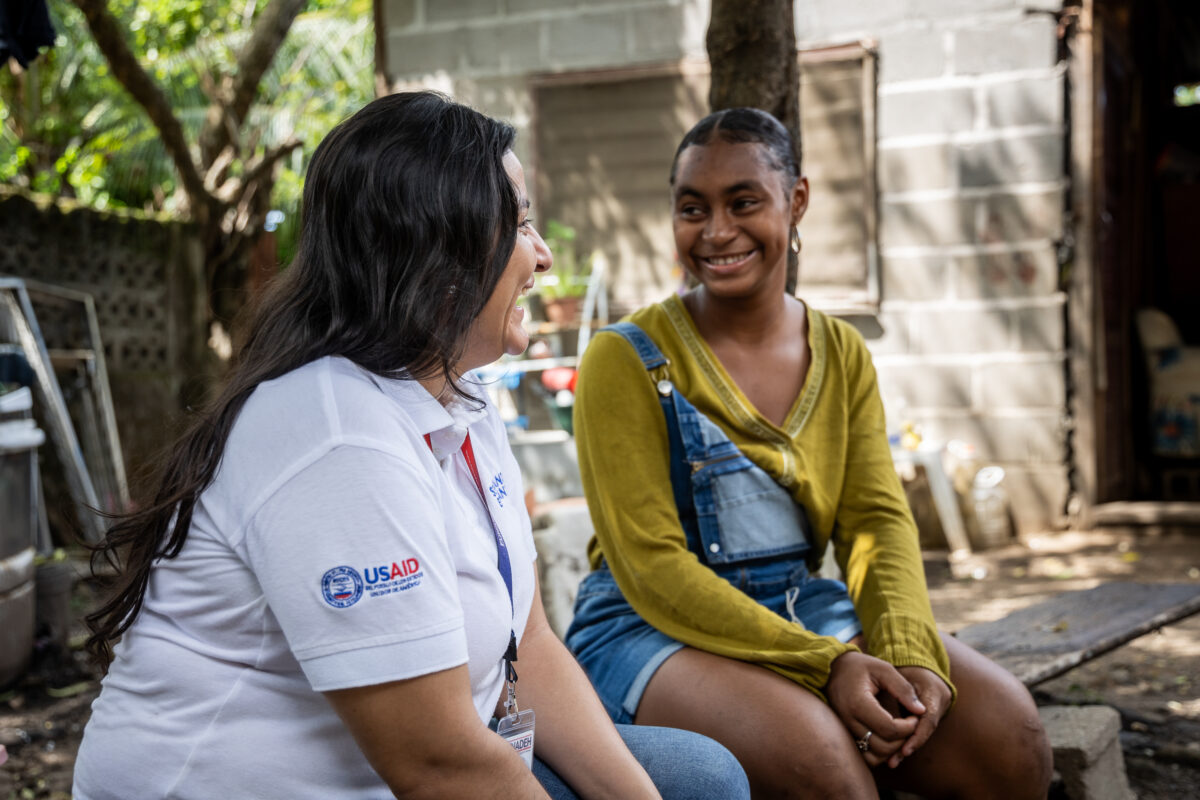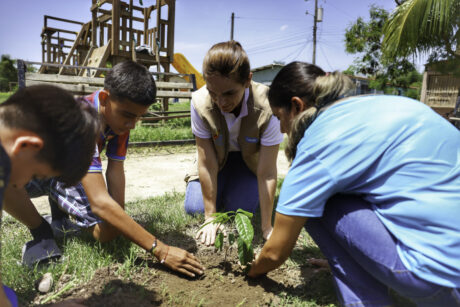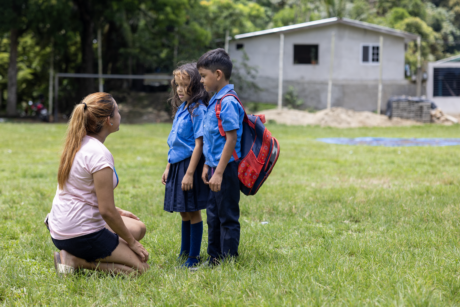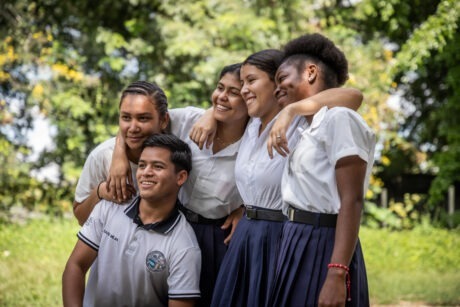Poverty, crime and violence plague parts of Honduras, driving irregular migration to neighboring countries.
The five-year Sembrando Esperanza (“planting hope” in Spanish) Activity focuses on local solutions to crime, violence and migration in Honduras. Funded by the U.S. Agency for International Development and implemented by Creative Associates International, Sembrando Esperanza, the program focuses on building youth capacities and ownership of local challenges.

Four members of the Sembrando Esperanza (SE) team in Honduras told us about their locally owned approach to reducing rates of violence and irregular migration.
What is the mission and vision of Sembrando Esperanza, and what sets it apart from similar initiatives in Honduras and elsewhere?
Robyn Braverman, Chief of Party:
The mission and vision of Sembrando Esperanza are reflected in their activities and programs through a comprehensive approach to reducing violence and irregular migration in Honduras. To achieve this goal, they focus on prevention services at the youth and family level that are comprehensive, evidence-based, and differentiated by risks. These services are implemented by capable local actors and supported by resourced institutions, as well as by protective community networks. All of this is anchored in local and national frameworks that facilitate and support these initiatives.
Our theory of change is based on improving human security in communities, with a special focus on youth and families at risk of violence and irregular migration. We believe that by enhancing this human security and sustainably increasing the performance of local prevention systems, irregular migration and violence in target areas will be measurably reduced.
What sets Sembrando Esperanza apart from similar initiatives in Honduras and elsewhere is its human security approach, as well as its emphasis on building long-standing local protection networks and services that generate evidence to drive public policies that foster changes and strengthen ties with communities.
How does Sembrando Esperanza collaborate with local and international organizations to maximize its impact and reach?
Esdras López, Deputy Chief of Party and Violence Prevention Advisor:
Sembrando Esperanza is characterized by developing coordination at different levels to drive processes. For example, in the development of the strategy for local systems of reference and counter-reference, coordination has been established with various implementers from USAID, who participate at a strategic level in a coordination committee. At the regional level, coordination is established with field teams to promote service provider ecosystems in municipalities. Additionally, Sembrando Esperanza collaborates with local governments to strengthen local services and improve their connection with the community. Actions and processes are also promoted with community-based organizations in neighborhoods and colonies, aiming to generate comprehensive actions for violence and migration prevention.
What are the main challenges faced by youth and communities where Sembrando Esperanza operates, and how does the activity address these challenges?
Marcelo Villalvir, Senior Advisor for Migration and Youth:
Sembrando Esperanza implements actions in municipalities with contexts of high violence and irregular migration, especially among youth, situations that primarily disadvantage women, young men, indigenous populations, and the LGBTQ+ community.
They face the following challenges within their communities and families:
- Family and community spaces that do not guarantee safety, freedom from gender-based violence, or protection.
- A lack of opportunities for income generation.
- Climate change impacts on production areas, housing, food security and public infrastructure.
- Political and social conflict and high levels of corruption.
- Vulnerability to exploitation and recruitment by criminal groups.
- Mental and emotional health challenges resulting from violence and irregular migration.
Sembrando Esperanza, to address these challenges, has defined a model framed in comprehensive approaches that address the underlying causes of violence and irregular migration. They also address the specific needs of youth by improving protective spaces in families and communities, increasing community participation and cohesion, providing psychosocial support, and linking them to services. Additionally, they promote programs and policies focused on violence prevention, irregular migration, economic opportunities, quality education, and strengthening youth resilience in these contexts.
What notable results and achievements has Sembrando Esperanza attained since its inception?
Esdras López, Deputy Chief of Party and Violence Prevention Advisor:
Some early victories include:
- Expanding the reach of the family systems-based prevention and intervention model to seven new municipalities in the country where no differentiated violence prevention services by risk level had previously been conducted.
- Expanding the scope and focus of the risk behavior measurement tool, which has led to the development of IMC++ and IMC++A [behavioral measurement tools] to measure risks related to violence, problematic behavior, intention to migrate, gender roles and perspectives, and trauma in youth aged 12 to 29.
- Engaging the private sector in co-creation processes with youth to drive violence prevention and irregular migration actions in communities with high levels of violence and migration in the municipality of La Lima.
- Designing and initiating the pilot of an intervention aimed at the reintegration of returned migrants to reduce migration incidence.
How does Sembrando Esperanza assess the impact of its programs on communities and the lives of participating youth?
Esdras López, Deputy Chief of Party and Violence Prevention Advisor:
Sembrando Esperanza utilizes various mechanisms to evaluate, measure, and generate evidence about its interventions. The IMC++ and IMC++A allow us to measure the reduction of violence risk, intention for irregular migration, and perception of gender roles in youth aged 12 to 29 after an intervention. To identify improvements in collective effectiveness, SE has designed an effectiveness index applied before developing intervention processes and months after these interventions, to measure whether the effectiveness of these communities has changed or not. Additionally, evaluations are designed to measure the impact of intervention models or methodologies addressing violence and irregular migration prevention, such as the family support network model, the pilot family counseling with adults, or the reintegration program to reduce migration recidivism.
What is the role of the private sector?
Janina Lima, Public-Private Partnerships Advisor:
The role of the private sector in Sembrando Esperanza is crucial for achieving the sustainability of SE’s initiatives in preventing violence and irregular migration. Each actor within the private sector plays a different role. Civil Society Organizations are fundamental in communities, empowering and strengthening their capacity for action and promoting their active participation in decision-making, while also raising awareness and educating communities. On the other hand, private companies are key players in community development. SE forms partnerships that mobilize the financial, human, equipment, facilities, and in-kind donations needed by communities to improve their living conditions.
The interdependence of both sectors, public and private, is necessary for the country’s development. Sembrando Esperanza recognizes the need for a collaborative approach to address social challenges that trigger violence and irregular migration, two factors that are reducing our development capacity and causing profound damage to the foundation of society, which is the family.
What lessons have been learned from Sembrando Esperanza’s experiences, and how are these lessons applied to continuously improve activities and strategies?
Esdras López, Deputy Chief of Party and Violence Prevention Advisor:
Learning within Sembrando Esperanza is ongoing. One of the lessons learned includes the need to enhance and strengthen family care models according to risk levels. Currently, SE is working on a methodological adaptation of this model, which will be implemented between May and October 2024. Another important lesson is the necessity to adapt to local contexts for effective action implementation. For instance, the lack of mental health services in the country and limited specialized intervention capacities have led SE to develop an adaptive strategy in collaboration with the Honduran Ministry of Health and the National Autonomous University of Honduras. Additionally, the significance of enhancing the capabilities of local partners has been identified. To address this, SE has bolstered the monitoring and technical support team, which will not only assist in intervention design but also in the technical implementation process alongside local partners
Robyn Braverman, Chief of Party:
- Local capacity-building processes take longer than expected.
- It is difficult to measure changes in processes since each organization, each municipality, and each person requires different support.
- It is difficult to foster a commitment/sense of co-responsibility.



